*NURSING > QUESTIONS & ANSWERS > NUR 3065: Chapter 16. Endocrine/Metabolic Problems, Latest 2020 Solution Guide, Attempt Score; 100% (All)
NUR 3065: Chapter 16. Endocrine/Metabolic Problems, Latest 2020 Solution Guide, Attempt Score; 100% Correct.
Document Content and Description Below
NUR 3065: Chapter 16. Endocrine/Metabolic Problems Multiple Choice Identify the choice that best completes the statement or answers the question. 1. A patient is 66 inches in height, weighing ... 200 pounds, and newly diagnosed with type 2 diabetes mellitus (DM). Her fasting plasma glucose level is 215 mg/dL. What is the best initial treatment? a. No treatment at this time b. Diet and exercise for 6-week trial c. Diet, exercise, and oral medication d. Diet, exercise, and exogenous insulin 2. The clinician suspects that a client seen in the office has hyperthyroidism. Which of the following tests should the clinician order on the initial visit? a. High sensitivity thyroid-stimulating hormone (TSH) and free T4 b. Free T4 and serum calcium c. Free T3 and T4 d. TSH and thyroxin antibodies 3. A patient with type 2 diabetes asks the clinician why she needs to exercise. In order to answer her, the clinician must understand that exercise has what effect on the patient with type 2 diabetes? a. Reduces postprandial blood glucose b. Reduces triglycerides and increases high-density lipoprotein (HDL) c. Reduces total cholesterol d. All of the above 4. A patient with type 1 diabetes comes to the clinic complaining of feeling nervous and clammy. He states that he took his insulin this morning but was late for work and did not eat breakfast. Which action should the clinician take first? a. Check his blood sugar. b. Have him drink 4 ounces of juice. c. Call 911. d. Ask him about his usual eating habits. 5. A patient with type 2 diabetes comes to the clinic after reading about metformin in a magazine. Which of the following conditions that the patient also has would be a contraindication to taking metformin? a. Ketoacidosis b. Cirrhosis c. Hypoglycemic episodes d. All of the above 6. A 25-year-old patient presents to the clinic with fatigue, cold intolerance, weight gain, and constipation for the past 3 months. On physical examination, the clinician notices a sinus bradycardia; muscular stiffness; coarse, dry hair; and a delay in relaxation in deep tendon reflexes. Which of the following tests should be ordered next? a. Serum calcium b. TSH c. Electrolytes d. Urine specific gravity 7. The clinician has been doing diabetic teaching for a patient with type 1 diabetes. Which of the following statements by the patient would indicate that teaching has been effective? a. “As long as I don’t need glasses, I don’t have to worry about going blind.” b. “I know I need to have my eyes checked every year.” c. “My optometrist checks my eyes.” d. “I will see my eye doctor when my vision gets blurry.” 8. A 64-year-old man with type 2 diabetes presents to the clinic with the complaint of “my feet feel like they are on fire.” He has a loss of vibratory sense, +1 Achilles reflex, and a tack embedded in his left heel. Which of the following would be an appropriate treatment? a. Tricyclic antidepressants b. Capsaicin cream c. Vitamin B12 injections d. Insulin 9. After removing a tack from a type 2 diabetic’s heel and evaluating the site for infection, what is the best plan for this patient? a. Suggest she use a heating pad to improve circulation. b. Refer to a podiatrist for a foot care treatment plan. c. Send her for acupuncture treatments. d. All of the above 10. Joyce is seen in the clinic complaining of vague symptoms of nervousness and irritability. She says that her hair will not hold a permanent wave anymore. On physical examination, the clinician finds an irregular heartbeat and brisk reflexes. The differential diagnosis should include which of the following conditions? a. Myxedema b. Thyrotoxicosis c. Cushing’s syndrome d. Pan-hypopituitarism 11. The patient is prescribed radioactive iodine (RAI) and asks the clinician how this drug works. The clinician’s response should include which of the following data? a. RAI prevents the peripheral conversion of T4 to T3. b. RAI binds free T4. c. RAI destroys thyroid tissue. d. RAI reduces freely circulating iodine. 12. A patient is diagnosed with hypothyroidism. Which of the following electrocardiogram changes should the clinician expect as a manifestation of the disease? a. Sinus bradycardia b. Atrial fibrillation c. Supraventricular tachycardia d. U waves 13. After 6 months of Synthroid therapy, the clinician should expect which of the following in the repeat thyroid studies? a. Elevated TSH b. Normal TSH c. Low TSH d. Undetectable TSH 14. Which of the following laboratory findings should the clinician expect in a patient with untreated Graves’ disease? a. Elevated TSH b. Elevated T4 c. Elevated thyrotropin-releasing hormone (TRH) d. All of the above 15. The clinician prescribes glipizide (Glucotrol) for a diabetic patient. Which statement made by the patient would indicate that your teaching has been effective? a. “I’ll take my pill at least 30 minutes before breakfast.” b. “I’ll take my Glucotrol before bedtime.” c. “It is important to take my medication right after I eat.” d. “Since I only like to eat two meals a day, I can take the pill between my meals.” 16. A diabetic patient asks the clinician why he needs to check his blood sugar at home even when he feels good. Which of the following responses would be most appropriate? a. “Control of glucose will help postpone or delay complications.” b. “Regularly checking blood sugar will help establish a routine.” c. “Monitoring glucose will promote a sense of control.” d. All of the above 17. How often should the clinician examine the feet of a person with diabetes? a. Once a year b. Every 6 months c. Every 3 months d. Every visit 18. The clinician sees a patient who is 5 feet tall and weighs 150 pounds. How would the clinician classify this patient? a. Overweight b. Mild obesity c. Moderate obesity d. Morbid obesity 19. Mr. S presents in the clinic with pain, tenderness, erythema, and swelling of his left great toe. The clinician suspects acute gout. Which of the following should the clinician expect in the initial test results for this patient? a. Elevated uric acid level b. Elevated blood urea nitrogen c. Decreased urine pH d. Decreased C-reactive protein 20. Mr. W, 53 years old, is seen in the clinic with concerns about his left foot. He has a 40-year history of type 1 diabetes with “fairly good” control on twice-daily insulin. He denies injury but states that he tripped a few months ago and that his foot is sore when he walks. Physical examination reveals an edematous, erythremic, and warm foot. There is a superficial ulcer on the plantar surface. Which of the following is the most likely diagnosis? a. Fallen arch b. Arthritis c. Charcot joint d. Sprained ankle 21. Which of the following tests should you order to confirm Mr. W’s diagnosis? a. Bone scan b. Computed tomography (CT) scan c. X-ray of the foot d. Culture of the ulcer 22. A vegetarian patient with gout asks the clinician about food he should avoid. The clinician should advise the patient to avoid which of the following foods? a. Rice b. Carrots c. Spinach d. Potatoes 23. The clinician should question the patient with suspected gout about use of which of these medications? a. Low-dose aspirin b. Thiazide diuretics c. Ethambutol d. All of the above 24. The clinician finds numerous nodules on the thyroid of a 65-year-old woman. The clinician suspects thyroid cancer. Which of the following data would be most significant for this patient? a. A history of tonsillectomy in the 1940s b. Recent exposure to mumps c. Vegetarian diet d. Allergy to iodine 25. Which of the following is essential for diagnosing thyroid cancer? a. Fine needle aspiration b. Thyroid ultrasound c. CT scan d. Magnetic resonance imaging 26. Which of the following are common signs of type 2 DM? a. Anorexia b. Recurrent yeast infection c. Weight gain d. Elevated HDL cholesterol 27. Which of the following medications can cause hyperglycemia? a. Prednisone b. Metformin c. Synthroid d. Cephalexin 28. Which of the following is diagnostic for diabetes mellitus? a. A1C 7.0 on one occasion b. Fasting blood sugar (FBS) of 100 mg/dL on two occasions c. Random glucose of 200 mg/dL on two occasions d. Two-hour post-load plasma glucose of 300 mg/dL on one occasion 29. Which of the following medications for type 2 diabetes mellitus should not be prescribed during pregnancy? a. Insulin b. Metformin c. Glucotrol d. Precose 30. A 35-year-old woman presents with symptoms of hypoglycemia. There is no history of diabetes mellitus. Which of the following should be included in the differential diagnosis? a. Anxiety disorder b. Pheochromocytoma c. Psychosis d. All of the above True/False Indicate whether the statement is true or false. 1. Metformin is the first line of pharmacologic treatment for type 2 DM. 2. Fruit juice with added sugar is the treatment of choice for anyone experiencing hypoglycemia. 3. Lifestyle modification is the treatment of choice for metabolic syndrome. 4. A BMI of 29 kg/m2 is considered obesity. 5. Urine-free cortisol is one of four diagnostic tests recommended for Cushing’s syndrome. [Show More]
Last updated: 1 year ago
Preview 1 out of 6 pages

Buy this document to get the full access instantly
Instant Download Access after purchase
Add to cartInstant download
We Accept:

Reviews( 0 )
$8.00
Document information
Connected school, study & course
About the document
Uploaded On
Feb 17, 2020
Number of pages
6
Written in
Additional information
This document has been written for:
Uploaded
Feb 17, 2020
Downloads
0
Views
44

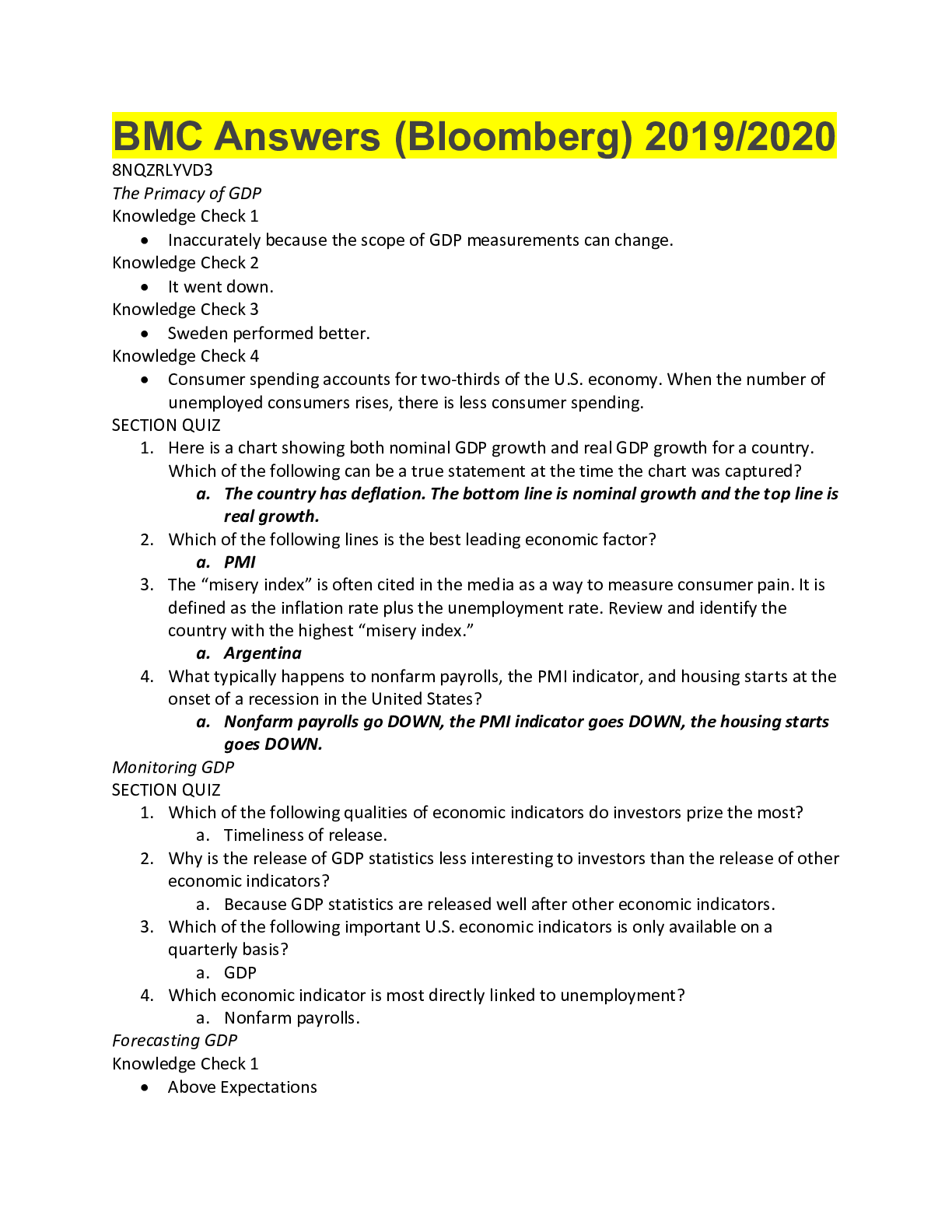
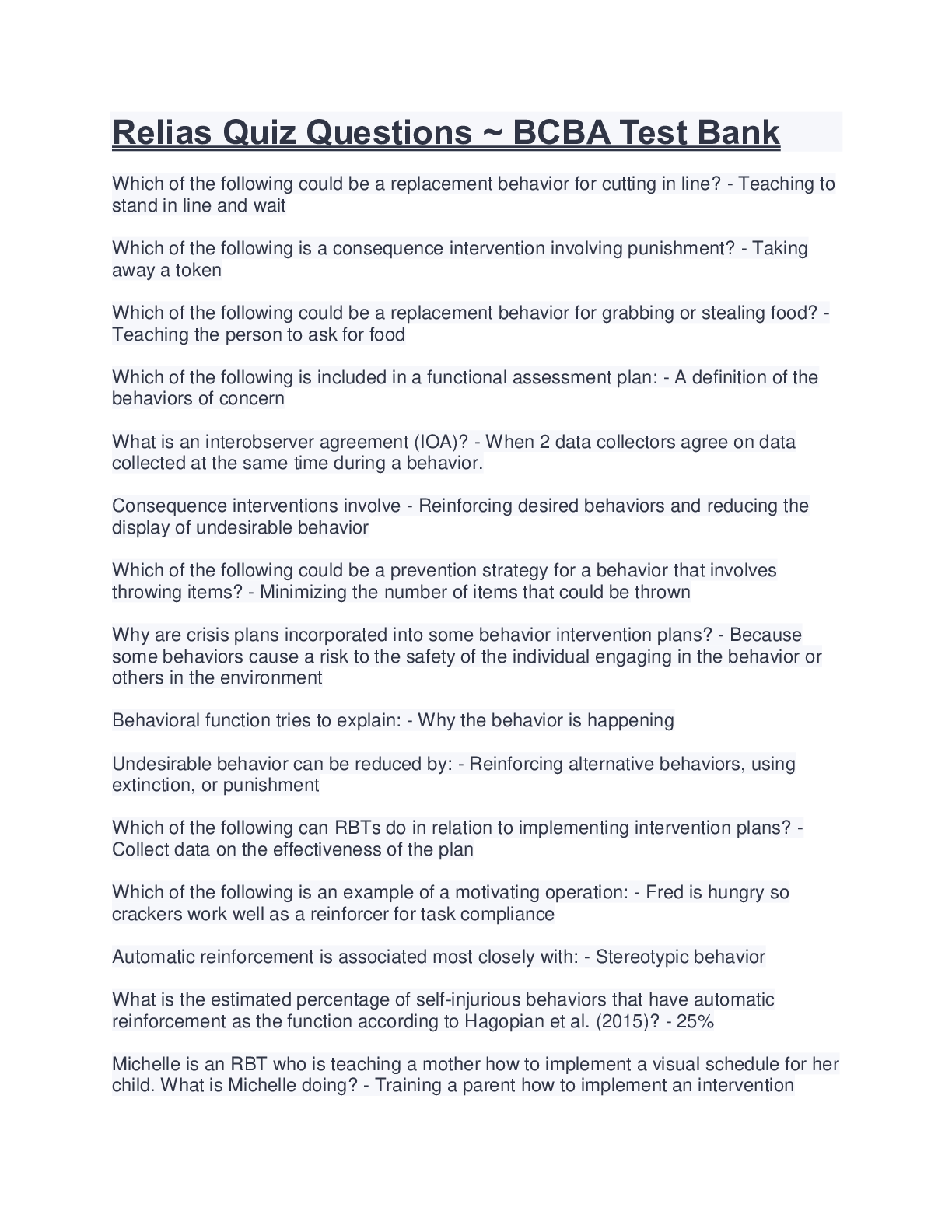
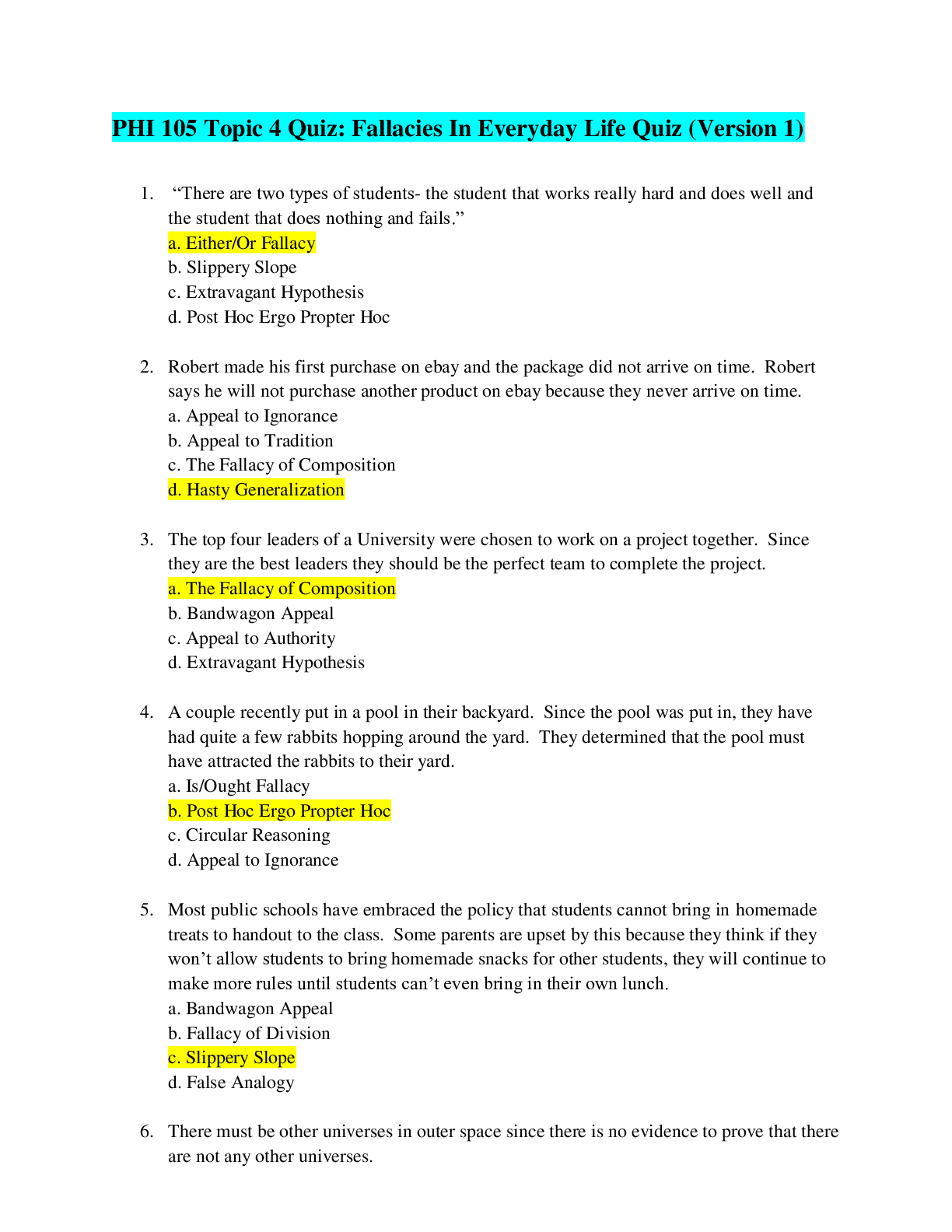


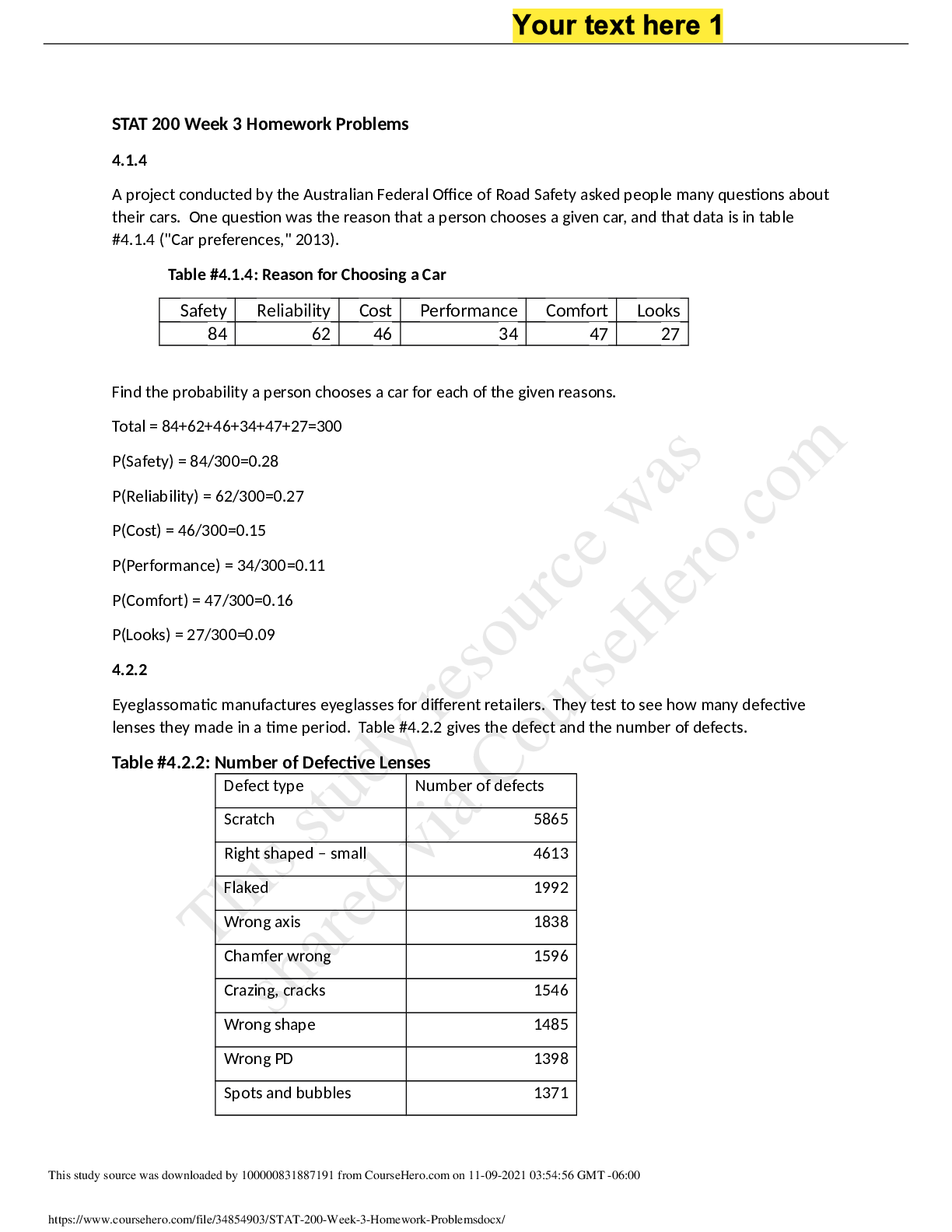

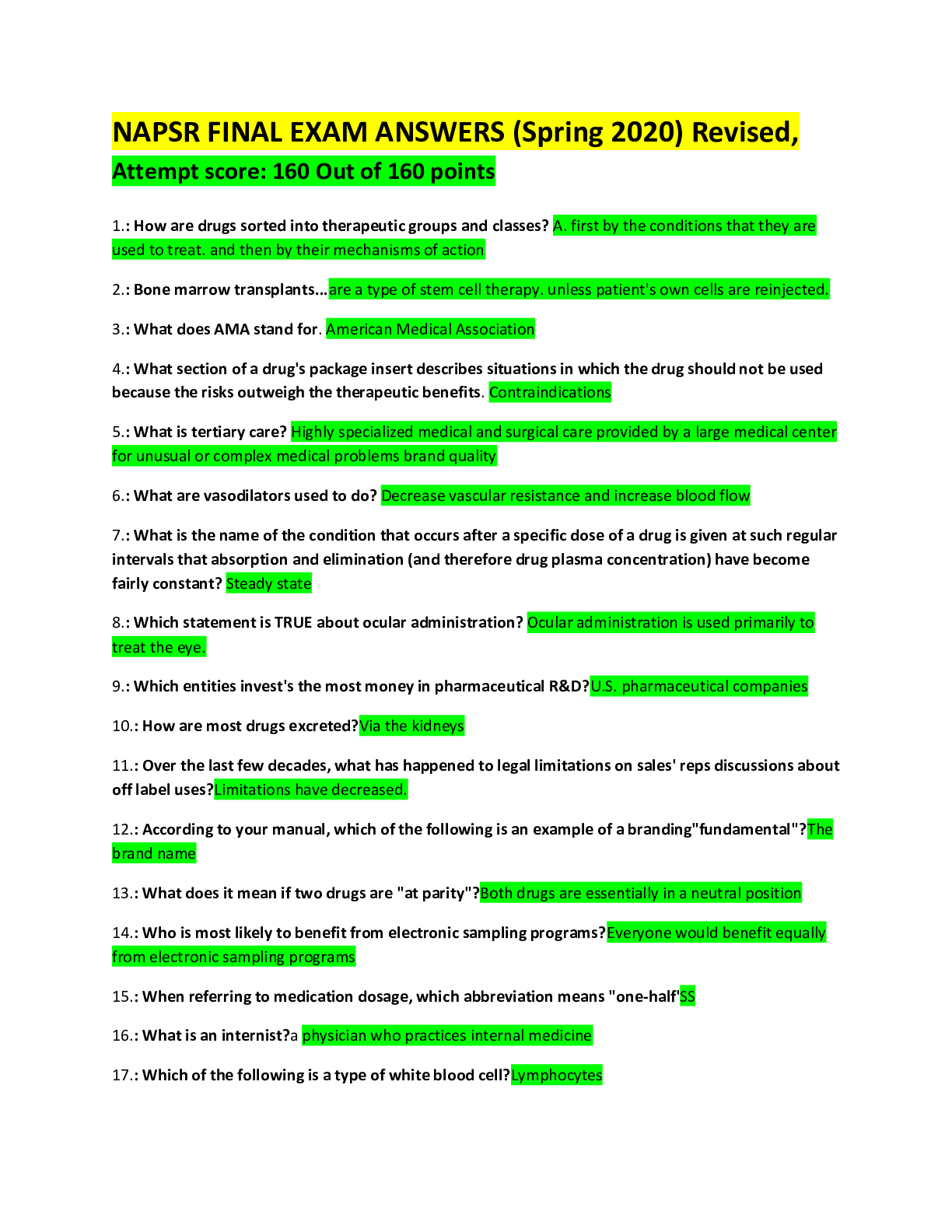

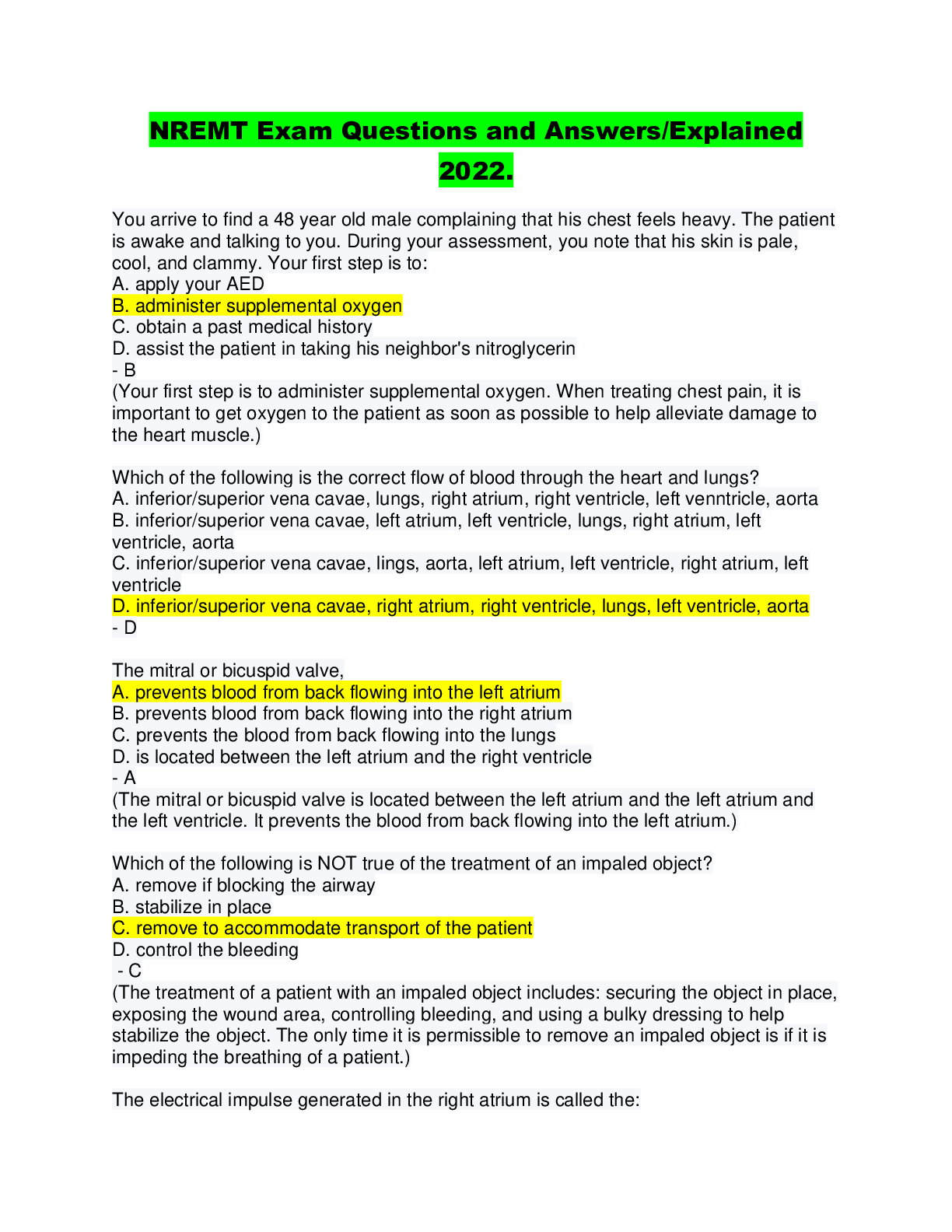
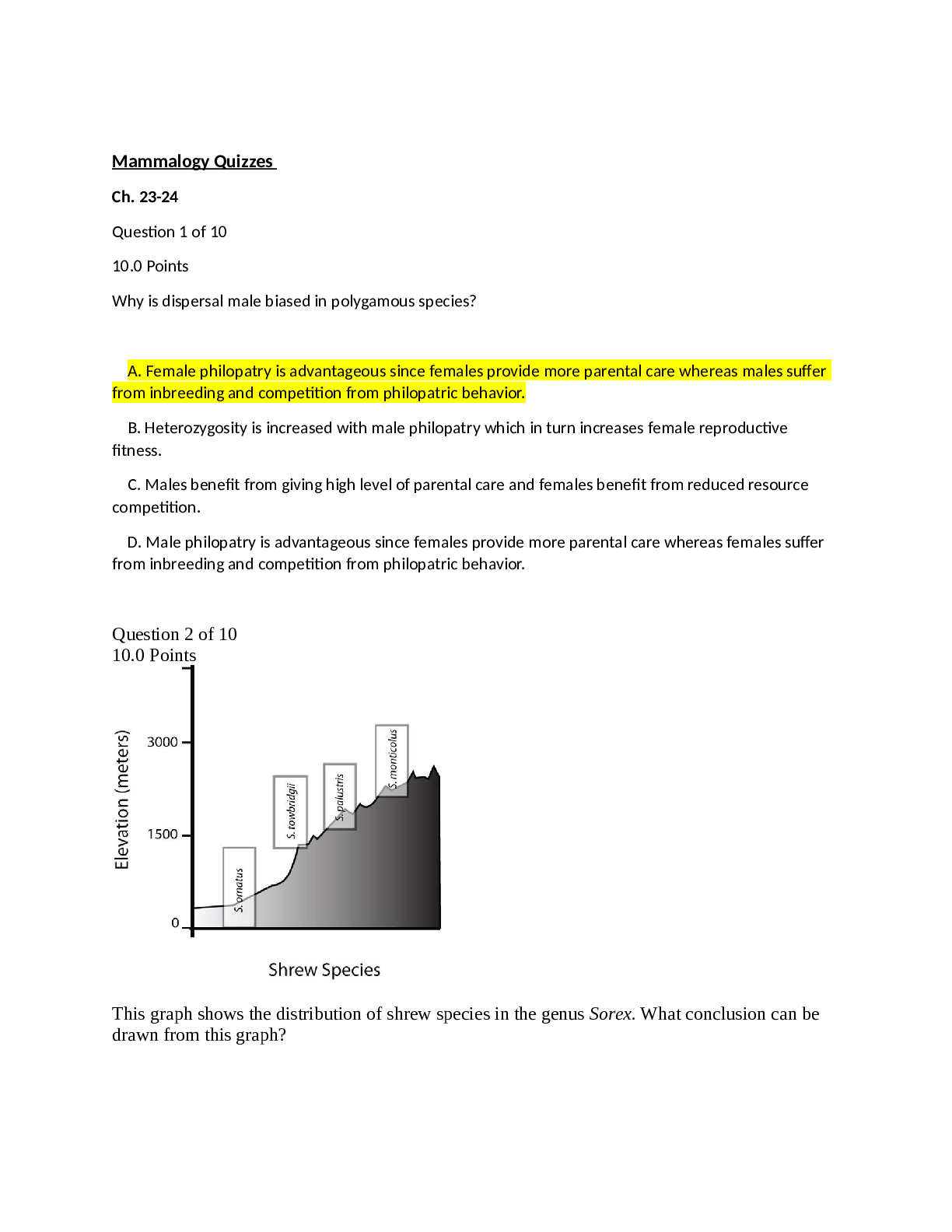
.png)

